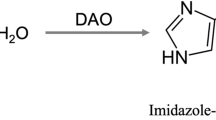Abstract.
Biogenic amines, e.g. histamine, occur in many different foods. At high concentrations, they are risk factors for food intoxication, whereas moderate levels may lead to food intolerance. Sensitive persons, with insufficient diamine oxidase activity, suffer from numerous undesirable reactions after intake of histamine containing foods. Besides spoiled foodstuffs, especially fermented foods tend to contain elevated levels of biogenic amines, although their concentrations vary extensively not only between different food varieties but also within the varieties themselves. High histamine content in foods and beverages result from microbial contamination. The evidence of enteral histaminosis represents a challenge for the food industry to produce foods with histamine levels as low as possible. We therefore investigated critical steps for histamine formation during food production processes, and established production methods that include low-histamine technology.
Similar content being viewed by others
Author information
Authors and Affiliations
Additional information
Received 10 February 1998; returned for revision 3 April 1998; accepted by E. Neugebauer 8 March 1999
Rights and permissions
About this article
Cite this article
Bodmer, S., Imark, C. & Kneubühl, M. Biogenic amines in foods: Histamine and food processing. Inflamm. res. 48, 296–300 (1999). https://doi.org/10.1007/s000110050463
Published:
Issue Date:
DOI: https://doi.org/10.1007/s000110050463




